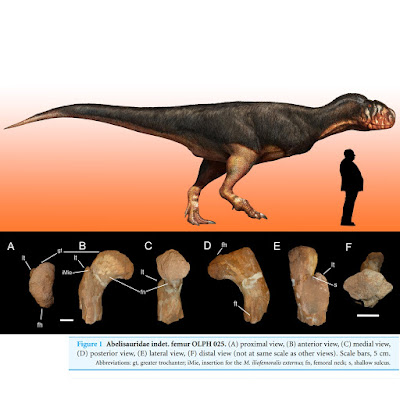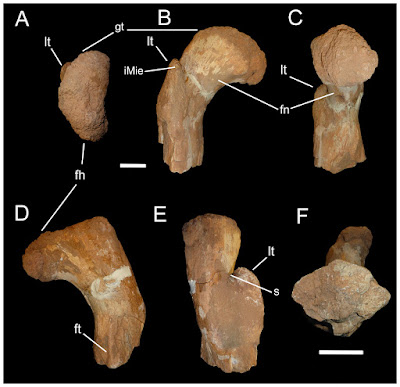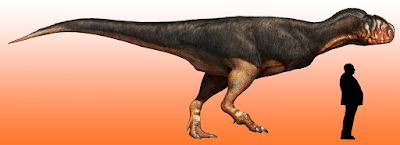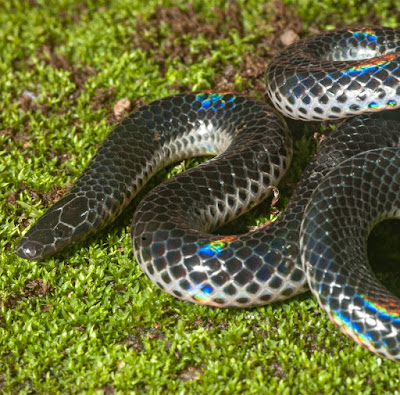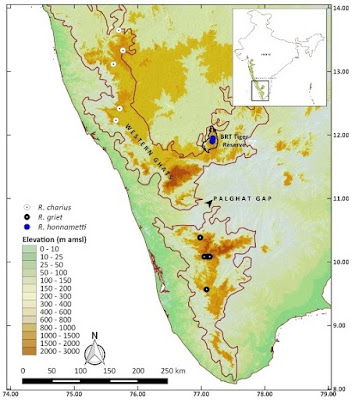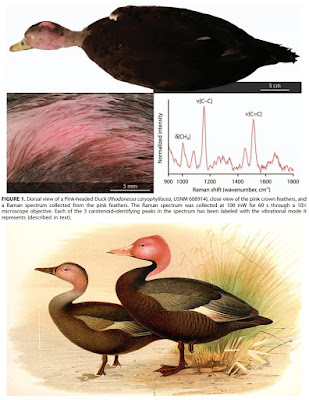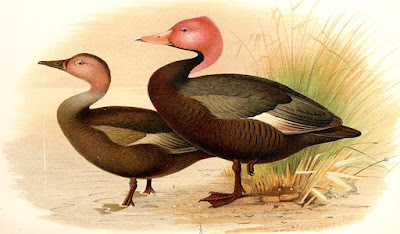[Most Recent Entries] [Calendar View]
Monday, March 7th, 2016
| Time | Event | ||||
| 1:36a | [Paleontology • 2016] A Large Abelisaurid (Dinosauria, Theropoda) from Morocco and comments on the Cenomanian Theropods from North Africa
Abstract We describe the partially preserved femur of a large-bodied theropod dinosaur from the Cenomanian “Kem Kem Compound Assemblage” (KKCA) of Morocco. The fossil is housed in the Museo Geologico e Paleontologico “Gaetano Giorgio Gemmellaro” in Palermo (Italy). The specimen is compared with the theropod fossil record from the KKCA and coeval assemblages from North Africa. The combination of a distally reclined head, a not prominent trochanteric shelf, distally placed lesser trochanter of stout, alariform shape, a stocky shaft with the fourth trochanter placed proximally, and rugose muscular insertion areas in the specimen distinguishes it from Carcharodontosaurus, Deltadromeus and Spinosaurus and supports referral to an abelisaurid. The estimated body size for the individual from which this femur was derived is comparable to Carnotaurus and Ekrixinatosaurus (up to 9 meters in length and 2 tons in body mass). This find confirms that abelisaurids had reached their largest body size in the “middle Cretaceous,” and that large abelisaurids coexisted with other giant theropods in Africa. We review the taxonomic status of the theropods from the Cenomanian of North Africa, and provisionally restrict the Linnean binomina Carcharodontosaurus iguidensis and Spinosaurus aegyptiacus to the type specimens. Based on comparisons among the theropod records from the Aptian-Cenomanian of South America and Africa, a partial explanation for the so-called “Stromer’s riddle” (namely, the coexistence of many large predatory dinosaurs in the “middle Cretaceous” record from North Africa) is offered in term of taphonomic artifacts among lineage records that were ecologically and environmentally non-overlapping. Although morphofunctional and stratigraphic evidence supports an ecological segregation between spinosaurids and the other lineages, the co-occurrence of abelisaurids and carcharodontosaurids, two groups showing several craniodental convergences that suggest direct resource competition, remains to be explained. Systematic Palaeontology Dinosauria Owen (1842). Theropoda Marsh (1881). Abelisauridae Bonaparte (1991). Locality and age: Based on the registry of the OLPH, the specimen was collected nearby the Moroccan-Algerian boundary just south of Taouz (Errachidia Province, Meknès−Tafilalet Region), Morocco. Following Cavin et al. (2010), the age of this fossil is considered as Late Cretaceous (Cenomanian). Material: OLPH 025, partial proximal portion of a right femur (Fig. 1).
Conclusions The taxonomy and inclusiveness of the theropod clades from the “middle” Cretaceous of North Africa is complex and problematic. Since Stromer (1931) and Stromer (1934) the minimum number of taxa recovered from these fossil associations has been considered controversial, in particular due to the fragmentary nature of most of the specimens found. Stromer himself (1934) was aware of this as one of the main problems in North African dinosaur palaeontology. Several factors, both biological and geological, may bias the taxonomic composition of the North African theropod faunas. Most North African units are poorly constrained stratigraphically (see Cavin et al., 2010; Fanti et al., 2014), thus preventing detailed correlations between the various localities. For example, the age of the KKCA has been alternatively placed between the Aptian and the Cenomanian (Russell, 1996; Cavin et al., 2010), and both number of and relationships among the units represented by that assemblage remain controversial (Sereno et al., 1996; Cavin et al., 2010). The temporal extent of these assemblages is uncertain, possibly spanning several million years (Cavin et al., 2010). Therefore, the application of biological (neontological) “rules,” based on ecological models and data from modern ecosystems (in order to constrain the number of carnivorous taxa included in a fossil assemblage) is often not adequately justified or not testable. This is particularly problematic for fossil assemblages, like the KKCA, that lack present-day analogues and where an unusually unbalanced ecological web has been suggested (e.g., Läng et al., 2013). Since the co-occurrence in the same North African theropod associations of distinct species belonging to the same clade has been documented (e.g., spinosaurids, Fanti et al., 2014; Hendrickx, Mateus & Buffetaut, 2016; carcharodontosaurids, Cau, Dalla Vecchia & Fabbri, 2012; Cau, Dalla Vecchia & Fabbri, 2013), the referral of all isolated elements of one lineage to a single species cannot be justified. Furthermore, the referral of isolated and non-overlapping material to the same species is a phylogenetic hypothesis itself that needs to be explicitly tested by numerical analyses. In absence of positive evidence supporting the referral of such material to a particular species, the inclusion of non-overlapping elements into a single taxon may led to the creation of a potential chimera, with unpredictable effects on the phylogenetic and palaeoecological interpretation of these faunas. We have described the fragmentary femur of a large-bodied theropod from the “Kem Kem Compound Assemblage” of Morocco. The specimen lacks tetanuran synapomorphies and is referred to Abelisauridae as it shares the overall morphology of the femora of ceratosaurians and the stocky robust proportions of some Late Cretaceous abelisaurids (e.g., Ekrixinatosaurus, Majungasaurus, Carrano, 2007; Juarez-Valieri, Porfiri & Calvo, 2011). The large size of the preserved femur suggests an individual comparable in body size with the type specimens of Carnotaurus sastrei and Ekrixinatosaurus novasi, both estimated to reach 9 meters in length and approaching two tons in body mass (Juarez-Valieri, Porfiri & Calvo, 2011). This discovery further supports that abelisaurids had evolved their largest size no later than the “mid-Cretaceous” (Smith et al., 2010; Juarez-Valieri, Porfiri & Calvo, 2011) and that abelisaurids and carcharodontosaurids co-existed and ecologically overlapped in both North Africa and South America during the Aptian-Turonian. Based on comparison with other “middle Cretaceous” units (Juarez-Valieri, Porfiri & Calvo, 2011; Fanti et al., 2014), we suggest that the co-occurrence of spinosaurids and other large theropods (abelisaurids and carcharodontosaurids) in the KKCA may be mainly an artefact due to poor stratigraphic resolution rather than genuine evidence of ecological and environmental overlap. Given the convergent evolution of several craniodental features among abelisaurids and carcharodontosaurids (Lamanna, Martinez & Smith, 2002; Sampson & Witmer, 2007; Carrano & Sampson, 2008; Cau, Dalla Vecchia & Fabbri, 2013), suggesting similar ecological adaptations in these clades, how these apparently competing groups co-existed for at least 30 million years in both Africa and South America remains to be resolved. Alfio Alessandro Chiarenza and Andrea Cau. 2016. A Large Abelisaurid (Dinosauria, Theropoda) from Morocco and comments on the Cenomanian Theropods from North Africa. PeerJ. 4:e1754; DOI: 10.7717/peerj.1754 Fossil find reveals just how big carnivorous dinosaur may have grown | ||||
| 2:56p | [Botany • 2016] Disporum sinovietnamicum sp. nov. (Colchicaceae) from southwestern Guangxi, China Disporum sinovietnamicum R. C. Hu & Y. Feng Huang sp. nov. is described and from southwestern Guangxi, China. It is morphologically closest to D. jinfoshanense X. Z. Li, D. M. Zhang & D. Y. Hong, but differs by having stems that are 35–90 cm tall, narrowly lanceolate and thinly leathery leaves, and ovate and glabrous tepals. Ren-Chuan Hu, Wei-Bin Xu and Yun-Feng Huang. 2016. Disporum sinovietnamicum sp. nov. (Colchicaceae) from southwestern Guangxi, China. Nordic Journal of Botany. DOI: 10.1111/njb.00989 | ||||
| 3:01p | [Herpetology • 2016] A Reassessment of Melanophidium Günther, 1864 (Serpentes: Uropeltidae) from the Western Ghats of peninsular India, with the Description of A New Species; Melanophidium khairei
Abstract A new species of the uropeltid snake genus, Melanophidium Günther, 1864 is described based on a series of eight specimens. Melanophidium khairei sp. nov. is the fourth species described in the genus, and the first for 144 years. Superficially M. khairei sp. nov. resembles M. punctatum Beddome, 1871 in being piebald and punctate (and it was previously misidentified as M. punctatum), but in many scalation characters it more closely resembles M. wynaudense (Beddome, 1863). The new species occurs in southern Maharashtra, Goa, and northern Karnataka, in the Western Ghats region of peninsula India. It is the most northerly member of its genus. Lectotypes and paralectotypes are designated for M. wynaudense, M. bilineatum Beddome, 1870, and M. punctatum. A new key to the species of Melanophidium is presented. Aspects of the morphology, taxonomy and distribution of the three previously described species of Melanophidium are reviewed and revised. Keywords: Reptilia, Alethinophidia, shieldtail, snake, systematics, taxonomy David J. Gower, Varad Giri, Ashok Captain and Mark Wilkinson. 2016. A Reassessment of Melanophidium Günther, 1864 (Squamata: Serpentes: Uropeltidae) from the Western Ghats of peninsular India, with the Description of A New Species. ZOOTAXA. 4085(4); 481-503. http://www.mapress.com/j/zt/article/view/z Snake that remained hidden for 145 years found - @NatureInd http://www.natureasia.com/en/nindia/arti | ||||
| 4:13p | [Herpetology • 2016] Raorchestes honnametti • Integrative Taxonomic Approach for Describing a New Cryptic Species of Bush Frog (Raorchestes: Anura: Rhacophoridae) from the Western Ghats, India
Abstract A new cryptic species of bush frog Raorchestes honnametti sp. nov. is described from the south-eastern part of the Western Ghats, India. This newly described species belongs to the Charius clade and is morphologically similar to other clade members—R. charius and R. griet. Therefore, an integrative taxonomic approach based on molecular and bioacoustic analysis along with morphology was used to delimit the new species. Raorchestes honnametti sp. nov., is currently known only from Biligiri Rangaswamy Temple Tiger Reserve, a part of Biligiri Rangaswamy horst mountain range (a mountain formed due movement of two faults) formed during the Late Quaternary period (1.8–2.58 Ma). Discovery of cryptic species from a highly speciose and well-studied genus Raorchestes hints at the possible existence of several more cryptic species in this genus. We discuss the possible reasons for crypsis and emphasize the need for continued systematic surveys of amphibians across the Western Ghats. Raorchestes honnametti sp. nov. Gururaja, Priti, Roshmi and Aravind urn:lsid:zoobank.org:act:071B913C-BB18-4 Suggested common name: Honnametti Bush Frog. Holotype: BNHS 5941, an adult male collected by authors from Strobilanthus shrubs at 0.48m above ground at Honnametti, on 13th October 2012 at 20:20 h from Biligiri Rangaswamy hills (11.8987° N, 77.1741° E, 1659 m amsl). Paratypes: BNHS 5942, BNHS 5943, BNHS 5945 and BNHS 5946, male individuals collected by authors in Honnametti, collection date and place same as holotype. BNHS 5944, a male collected by authors on 14th October 2012 at 19:45 h Dodda Sampige (11.9473° N and 77.1836° E, 1142 m amsl). Diagnosis: Raorchestes honnametti belongs to the genus Raorchestes as they are relatively small sized frogs (15–45 mm), active in night, vomerine teeth absent, transparent/translucent vocal sac while calling and direct development without free swimming tadpoles. It is a small sized adult (male: 21.7–24.8 mm, n = 6); snout longer than the horizontal diameter of eye; groin uniform light brown with 3–4 yellow blotches; both anterior and posterior part of thigh uniform light brown with small round to oval shaped yellow blotches and relatively short hind limbs ShL/SVL ratio <0.5. It belongs to the Charius clade and morphologically similar to R. charius and R. griet. Etymology: Named after the locality of holotype – Honnametti. Honnametti is treated as an invariable noun in apposition to the generic name.
Natural history: Raorchestes honnametti sp. nov. is known only from Biligiri Rangaswamy hills and is one of the very common frogs in that landscape. It is found in shola forests, evergreen forests, semi-evergreen forests and around human habitations. Individuals were found calling in an open area within Ageratina adenophora (Asteraceae) and Strobilanthus bushes. Some individuals were also found on tree saplings in the understory. Individuals call at a perched height between 0.48–1.00 m from ground. Call starts at around 6 pm and goes till early morning. During monsoon (June to September), individuals call almost throughout the day except on days with heavy rains or dry days. Other anuran species like Pseudophilautus sp., Hylarana sp., Fejervarya sp., Duttaphrynus melanostictus, Microhyla sholigari, M. ornata, M. rubra and Euphlyctis cyanophlyctis co-occur with R. honnametti in Biligiri Rangaswamy hills. Conservation: There are no immediate threats from human activities to this newly described species as Biligiri Rangaswamy hills is a tiger reserve and enjoys high level of protection. However, in the last one decade, a significant area of the Reserve has been taken over by highly invasive species like Lantana camara (Verbenaceae) and Ageratina adenophora (Asteraceae). On subsequent visits, we have seen several calling males of R. honnametti on Lantana and Ageratina bushes, indicating that this species might have adapted to the presence of these invasive species. However, a systematic research needs to be undertaken to assess the impact of invasive species on R. honnametti. H. Priti , Rekha Sarma Roshmi, Badrinath Ramya, H. S. Sudhira, G. Ravikanth, Neelavara Anantharam Aravind, Kotambylu Vasudeva Gururaja. 2016. Integrative Taxonomic Approach for Describing a New Cryptic Species of Bush Frog (Raorchestes: Anura: Rhacophoridae) from the Western Ghats, India. PLoS ONE. DOI: 10.1371/journal.pone.0149382 | ||||
| 5:59p | [Ornithology • 2016] Nondestructive Raman Spectroscopy confirms Carotenoid-pigmented Plumage in the Pink-headed Duck Rhodonessa caryophyllacea
ABSTRACT A small group of pigment classes is responsible for the wide range of plumage colors in modern birds. Yellow, pink, and other “warm” feather colors of many species are attributed to carotenoid pigments, a plumage trait that has an uneven distribution across modern bird species. Carotenoid plumage pigments are especially rare among fowl (superorder Galloanseres), and until recently, the Pink-eared Duck (Malacorhynchus membranaceus) from Australia provided the only evidence that any species of waterfowl (order Anseriformes) exhibits carotenoid-pigmented plumage. We analyzed a Pink-headed Duck (Rhodonessa caryophyllacea) study skin using Raman spectroscopy, without plucking or otherwise damaging the specimen. Raman spectra confirmed that the pink feathers of Rhodonessa are pigmented with carotenoids. Spectra from Rhodonessa were similar to those from Malacorhynchus, which suggests that the same carotenoid is the primary plumage pigment in both species. Moreover, spectra from Rhodonessa were similar to spectra from other taxa pigmented with ketocarotenoids. Malacorhynchus and Rhodonessa are distant relatives within Anseriformes, so these findings indicate multiple evolutionary origins of plumage carotenoids within the waterfowl or (less likely) many losses of plumage carotenoids from duck species. Our results show that pigment chemistry can be studied in precious ornithological specimens without damaging the specimens, and provide new evidence that the (apparently extinct) Rhodonessa possessed what is evolutionarily an extremely rare trait among waterfowl. Keywords: Anseriformes, coloration, feather, pigmentation, Raman spectroscopy, Rhodonessa
Daniel B. Thomas and Helen F. James. 2016. Nondestructive Raman Spectroscopy confirms Carotenoid-pigmented Plumage in the Pink-headed Duck [La espectrometría Raman no destructiva confirma la pigmentación con carotenoides del plumaje de Rhodonessa caryophyllacea]. The Auk. 133(2) 147-154. DOI: 10.1642/AUK-15-152.1 Extinct pink-headed duck derived its unique color from carotenoids http://phy.so/373134159 via @physorg_com RESUMEN Un pequeño grupo de clases de pigmentos es responsable del amplio rango de colores del plumaje en las aves modernas. Amarillo, rosa y otros colores “cálidos” de las plumas de muchas especies son atribuidos a los pigmentos carotenoides, un rasgo del plumaje que tiene una distribución desigual entre las especies de aves modernas. Los pigmentos carotenoides del plumaje son especialmente raros entre las aves de caza (superorden Galloanseres) y hasta hace poco, la especie Malacorhynchus membranaceus de Australia representaba la única evidencia de una especie de ave acuática (orden Anseriformes) con plumaje pigmentado con carotenoides. Analizamos una piel de estudio de Rhodonessa caryophyllacea usando espectrometría Raman sin perforar o dañar el espécimen. El espectro Raman confirmó que las plumas rosas de Rhodonessa están pigmentadas con carotenoides. Los espectros de Rhodonessa fueron similares a aquellos de Malacorhynchus, sugiriendo que el mismo carotenoide es el principal pigmento del plumaje en cada especie. Más aun, los espectros de Rhodonessa fueron similares a los espectros de otros taxa pigmentados con ceto-carotenoides. Malacorhynchus y Rhodonessa son parientes distantes adentro de los Anseriformes, indicando orígenes evolutivos múltiples de los carotenoides del plumaje adentro de las aves acuáticas, o (menos probable) muchas pérdidas de los carotenoides del plumaje en las especies de patos. Nuestros análisis muestran que la química de los pigmentos puede ser estudiada en especímenes ornitológicos valiosos sin dañarlos, y brinda nueva evidencia de que la especie (aparentemente extinta) Rhodonessa poseía lo que es un rasgo evolutivo extremadamente raro entre las aves acuáticas. Palabras clave: Anseriformes, coloración, espectrometría Raman, pigmentación, plumas, Rhodonessa |
| << Previous Day |
2016/03/07 [Calendar] |
Next Day >> |
